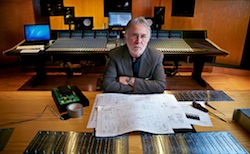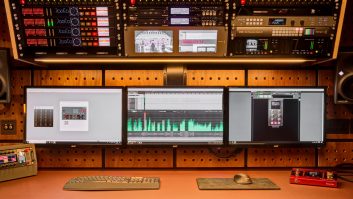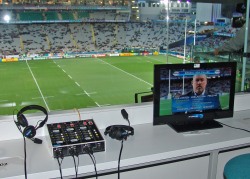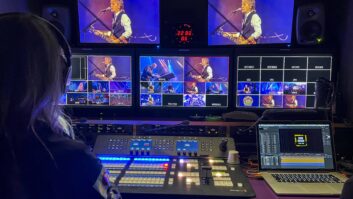
In the second of our Roundtable discussions, Philip Stevens poses key questions to seven manufacturers of OB audio mixing equipment: Calrec, DiGiCo,Harman Studer,Lawo, Roland, Solid State Logic and Stagetec.
When it comes to outside broadcasts, there is often a demand for complex audio mixing requirements – especially for high profile musical events — while coping with the limited space in trucks. Beyond that, new technologies have affected the design of consoles.
For example, what are the demands of 3D? What is the current thinking about layering? Just what does the future hold for audio mixing equipment? These, and other questions, are answered by our participations. They are (in alphabetical order) James Gordon, managing director of DiGiCo; Jim Green, Calrec UK sales manager; Andrew Hills, product director, Harman Studer Professional Audio; Chris Jenkins (pictured), director of Commercial Applications at Solid State Logic; Simon Kenning, sales manager, Roland Systems Group; Felix Krückels, senior product manager mc² series at Lawo; and Alexander Nemes on behalf of Stagetec.
TVBEurope: What has been your greatest challenge over the past 12-24 months?
Gordon: Establishing good connection with the market and launching a new range of consoles tailored to offering key features at a more budget-acceptable price.
Green: Adapting to the demands of HD and 3D, not only in terms of sheer number of channels, but also ensuring that control is simple and straightforward. With improvements in audio processing power and console features, the challenge is to maintain speed of operation, and easily accessible controls on an increasingly powerful product.
Jenkins: The general worldwide commercial climate. Luckily, we have a very distributed client base, with no specific reliance on a single area for the bulk of sales turnover.
Kenning: Working with our customers in a difficult economic environment, especially with the strength of some currencies, such as the Yen.
Krückels: Price competition is definitely one of the biggest challenges the industry is facing.
Nemes: The European Song Contest 2011 broadcast from Dusseldorf was an exciting project with four Aurus and a large Nexus network to produce the national and international sound feeds.
TVBEurope: What do you think has been the greatest innovation in audio mixers in the last five years?
Gordon: The speed of use and the ability to provide a greater number of channels and busses in line with the expansion of 5.1 programmes. The ability to de-embed and re-embed audio into a video stream is now standard practice.
Green: FPGA (field-programmable gate array) saves on power, space and cost, and this technology is arguably the biggest step change in audio processing history. Calrec’s Bluefin technology was the world’s first implementation of FPGA technology for full DSP, and provided enough processing on one DSP card to power an entire mixing console running surround sound productions.
Hills: Without question, the creation of the Vistonics user interface. After 20 years of assignable consoles this was the first time anybody made a digital console that could match analogue for speed and visibility in operation.
Jenkins: The chip hardware and manufacturing innovations that have allowed us to shrink down a 12U fully stuffed card frame to a single PCI (Peripheral Component Interconnect) card in a 2U chassis.
Kenning: As digital mixers have now completely replaced analogue the strongest innovations have been in huge jumps in the processing power of discrete DSP and, from a Roland point of view, the capabilities of FPGA and ancillary processors.
Krückels: From our perspective the integrated routing and massive DSP capacity changed audio mixers more than five years ago. A hot topic of the last two years is the levelling to loudness. It opens a completely different approach towards handling mixes in live production.
Nemes: Improvement of control surfaces, and quick and easy operation with direct access to all parameters, together with the full flexibility of individual configuration.
TVBEurope: Clearly, space limitations are a major factor in OB vehicles. Are there any other specific considerations when it comes to consoles in trucks?
Gordon: We have always believed the size of a console should not limit its processing capabilities. Our SD10-24 is a compact frame, but can still process the same amount of channels and busses. We have recently introduced ‘multi-channels’, which allows you to fold, for example, the six 5.1 sources under one fader and unfold them on to the surface when you need to adjust any parameters. We can fold up 11 sources under one fader, so in a music environment you could have all your drum microphones under just one fader.
Hills: Weight and mechanical stability is an issue with OB use. The packing of ever more transistors on to single chips helps both of these factors greatly. In 1985 a stereo DSP channel required a board 30cm square and 1000 chips. Nowadays, a board 10cm square with six chips can provide 96 DSP channels.
TVBEurope: How are you gearing up (or have already geared up) to handle the increasing demands for 3D production with associated 5.1?
Green: For 3D broadcasting, many live events are now covered by not one, but two OB trucks: one for the 2D mix, the other for 3D. While the audio kit might be the same and both tend to mix in 5.1, the mixes are quite different. One is for a standard HD output, the other for what we now call 3D audio. Calrec’s Hydra2 networks are designed to move such audio around very efficiently, with resources being instantly available to all consoles on the network. This connectivity can be expanded to MADI (Multichannel Audio Digital Interface), too. In fact, more and more trucks in this kind of set-up use MADI to transport signals between units.
Jenkins: SSL’s C100 was fully 5.1 compliant when first released in 2003. Out of the box we had single fader 5.1 channels complete with full surround EQ, compressors, and limiters as well as multi-fader spill. Dual 5.1 program busses and surround monitoring were also standard features. We have subsequently added user control over the 5.1 downmixing coefficients, stereo to 5.1 upmixing, and an integrated 5.1 media player to the surround feature set.
Nemes: One major point is integration in order to save space. For example, Stagetec Nexus today not only serves as audio matrix, but also takes over HDSDI embedding and de-embedding, Dolby E encoding and decoding etc. This makes things very compact and space saving in the OB truck.
TVBEurope: Is there a trend towards incorporating what, previously, would have been considered sub-mixers into the main consoles?
Gordon: As larger consoles do more, the requirement for sub-mixers is less — but we have seen the SD11 become an ideal sub mix solution. It is able to mount into a 19-inch rack, but can still output and monitor 5.1.
Hills: Yes and no. The large number of channels available in today’s mixers means that the need to bring in extra ‘side consoles’ for large LE shows is a thing of the past. However, it is simply not possible to have a single sound operator provide all the mixes (main 5.1, main stereo, PA, monitor and grams) required on a large TV show. It is also much safer to have different mix engines and control surfaces providing these mixes.
Jenkins: We are about to release new V5 software for C100 that enables Dual Operator Mode where a single console processor and I/O can be shared by two operators with independent control over PFL (Pre Fade Listen) etc. The second operator fader bays can be located away from the main console.
Kenning: Software addressable controls mean that is very easy for any manufacturer to add sub-mix capability either via a separate ‘mix on faders’ option on the main fader bank, easily configurable user layers, or to provide separate functional blocks of faders (usually groups of eight) and this trend will only grow.
TVBEurope: Do you favour layered GUI (graphical user interface)? If so, what do you think are the benefits? If not, what are your objections?
Gordon: Yes, we have always allowed layering and also user defined fader positions. The philosophy being anything wider than an arm’s width requires more movement to locate the channel than pushing a button to the layer. However, it does depend on what you are mixing. Our EX007 allows for the surface to be up to 100 faders, which makes for a big console, but lots of control.
Hills: Layered interfaces should be avoided as far as possible and always for viewing and controlling major console parameters such as metering, faders, EQ, pans etc. Layering does not provide the operator with a quick overview of what the console is doing — deadly in live to air operations.
Kenning: Nobody would choose a layered GUI if it were possible to provide everything on one screen without it being too cluttered, but the functionality possible in digital mixers is just too great to achieve without some layering and menus. One of the strengths of the Roland products has been identifying the essential functions that require dedicated hardware controls, those that can be accessed via cursor movement but are required on the top layer and those less important functions that can accessed by subsidiary screens.
Krückels: We have limited space on screens, just the same as on our mixing console surfaces. Whenever it is required to show or access more than is possible on the available screen or surface, layering is the answer. Nowadays, mc²66 or mc²56 consoles can handle sport productions, just as easily as music recording or drama with timecode automation. The important part in mixing console specification is to decide what information or settings need to be available all the time.
Nemes: I’m a big fan of layered GUI because I can always bring up parameters that matter most in the moment and obey anything that I don’t need to for my specific task. Thus, my surface is always intuitive and clearly arranged.
TVBEurope: How significant is interaction with comms providers?
Jenkins: We have made provision for AES and MADI encoded comms channels to transparently tunnel through our I/O infrastructure, plus we provide full GPIO (General Purpose Input/Output) access to standard console monitoring functions such as Mute and Dim. The provision of dual direct outputs and on each input channel, simplifies feeding pre fader listen signals to the comms system inputs without compromising mix minus or parallel record feeds from a channel.
Krückels: Intercom is the second biggest audio part in a truck, so the interaction with comms providers is very important. Unfortunately, a common understanding of networking a comms system with a mixing console has never been seen until today.
TVBEurope: Finally, what is your prediction for key future developments?
Gordon: I think the increase of 5.1 will see a further push on the channels and buss demands.
Green: With the move to FPGA based DSP, the revolution in audio processing power has already begun. The next big area of development will be in the sophistication of display technologies and interaction with the user interface.
Hills: Simple: more features, in smaller footprint, lighter and environmentally friendly packages.
Jenkins: The raw channel/bus count will undoubtedly increase for a given system price, as the cost of the DSP hardware falls. The requirement of tighter comms integration presents another challenge for console designers. Use of third party control integration adds another area for development.
Kenning: Continual development of the smaller form factor mixers, advances in digital protocols to achieve much higher bandwidth, possible standardisation of transport protocols to allow greater compatibility between manufacturers.
Krückels: Integration, ease of use, power and flexibility in processing and routing will be the major tasks.
Nemes: Even more DSP power due to multichannel production and hybrid surfaces featuring touch sensitive elements together with ‘traditional’ knobs and encoders.
www.calrec.com
www.digico.biz
www.lawo.de
www.roland.co.uk
www.stagetec.com
www.solid-state-logic.com
www.studer.ch
Mics in the mix
By Melanie Dayasena-Lowe
Sennheiser and Neumann microphones can form the front end of any audio mixing set up. The integration of its digital microphones with DiGiCo’s consoles was demonstrated at a series of digital training days, jointly organised by DiGiCo and Sennheiser UK, recently at Koolworld Studios in Luton.
Hosted for the first time in the UK, the ‘Digi Days’, were designed to demonstrate to engineers from different sectors of the pro audio industry just how simply digital microphones can now be integrated into today’s audio systems.
Microphones used included Neumann TLM 102 D large diaphragm condensers, KM D digital output stages fitted with a variety of capsules and, the digital mic that started it all for Neumann, the D-01. From Sennheiser’s range of microphones various capsules from the 8000 series as well as a pair of MKH 800 Twins were employed, all connected to MZD 8000 digital output modules.
Sennheiser UK’s Sound Reinforcement Specialist, Dave Wooster, was on hand to show attendees from the BBC and BSkyB among others the benefits that digital microphones can offer. “The idea was to demonstrate, in a real world environment, two things,” states Wooster. “Firstly, how easily digital microphones can be incorporated into a modern working environment; secondly, and perhaps more importantly, just how good their performance is. The lowering of the overall noise floor is noticeable and, as a result of hosting the days, many engineers are now looking to see how they can incorporate digital microphones into their upcoming projects.”
DiGiCo’s Tim Shaxson/Ian Staddon commented: “This was a great opportunity for DiGiCo to highlight the many advantages of its consoles, as well as for our two companies to show the true potential of an all digital system. We’ve had great feedback from the attendees and we’re delighted with the overall result.”







